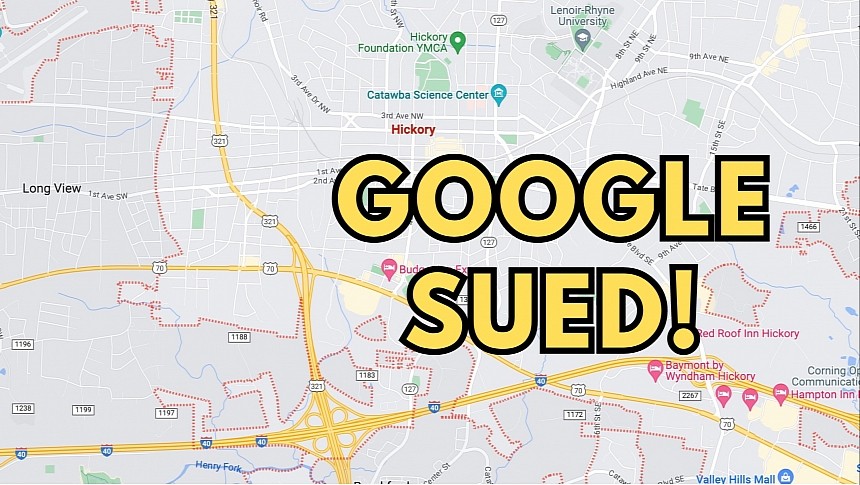Google Maps is once again under fire for broken navigation directions, this time after directing a man to cross a bridge that's been collapsed for five years.
A lawsuit filed this week alleges that Google has been informed several times that its navigation software doesn't provide accurate directions. Residents told Google about the bridge collapse, urging the company to update the maps and the navigation directions offered to users.
The lawsuit claims the search giant ignored all these requests, failing to update the Google Maps navigation. One user even used the "suggest an edit" feature in Google's mapping software to signal the error, but the map remained unchanged.
The man was driving home from his daughter's ninth birthday party when Google Maps told him to cross the collapsed bridge. The SUV plunged into Snow Creek and was found partially submerged some 20 feet (approximately 6 meters) below, the police explained.
The driver died, and his wife is now taking Google to court for failing to provide accurate directions on Google Maps and ignoring users' reports.
An email confirmation from November 2020 received from one of the users confirms the search giant received the suggested map edit – this was most likely an automatic reply, but the more important tidbit is that the suggestion was still ignored, leaving the collapsed bridge unmarked properly on Google Maps.
Unfortunately, the tragic story not only shows Google's inability to keep the map data up-to-date but also the limitations of sat-nav software. The problem resides in users blindly trusting navigation solutions, especially when driving on unfamiliar roads and ignoring street signs. In this case, Google Maps was the only source for route information, as the police claimed that they couldn't find any barriers or warning signs before the collapsed bridge.
Following sat-nav directions when going through unfamiliar neighborhoods is becoming very dangerous due to the lack of up-to-date data, with authorities sometimes erecting signs to tell drivers to ignore the navigation solutions in their cars. The efforts came after city councils failed to update the map data, so installing new road signage to raise awareness of the broken sat-nav directions was the only solution.
Tragedies still happen, though, as users misuse navigation applications and blindly trust everything they say. Drivers occasionally end up stranded in the middle of nowhere, sometimes with no cellular signals, while others are forced to spend their nights under the clear sky because they were directed on closed or damaged roads where their vehicles got stuck. In 2020, two Russians using Google Maps to find the fastest route were taken off the highway and sent to a closed road covered by snow. The driver eventually froze to death after the vehicle got stuck in the snow in an area with no cellular reception.
The lawsuit claims the search giant ignored all these requests, failing to update the Google Maps navigation. One user even used the "suggest an edit" feature in Google's mapping software to signal the error, but the map remained unchanged.
The man was driving home from his daughter's ninth birthday party when Google Maps told him to cross the collapsed bridge. The SUV plunged into Snow Creek and was found partially submerged some 20 feet (approximately 6 meters) below, the police explained.
The driver died, and his wife is now taking Google to court for failing to provide accurate directions on Google Maps and ignoring users' reports.
An email confirmation from November 2020 received from one of the users confirms the search giant received the suggested map edit – this was most likely an automatic reply, but the more important tidbit is that the suggestion was still ignored, leaving the collapsed bridge unmarked properly on Google Maps.
Unfortunately, the tragic story not only shows Google's inability to keep the map data up-to-date but also the limitations of sat-nav software. The problem resides in users blindly trusting navigation solutions, especially when driving on unfamiliar roads and ignoring street signs. In this case, Google Maps was the only source for route information, as the police claimed that they couldn't find any barriers or warning signs before the collapsed bridge.
Following sat-nav directions when going through unfamiliar neighborhoods is becoming very dangerous due to the lack of up-to-date data, with authorities sometimes erecting signs to tell drivers to ignore the navigation solutions in their cars. The efforts came after city councils failed to update the map data, so installing new road signage to raise awareness of the broken sat-nav directions was the only solution.
Tragedies still happen, though, as users misuse navigation applications and blindly trust everything they say. Drivers occasionally end up stranded in the middle of nowhere, sometimes with no cellular signals, while others are forced to spend their nights under the clear sky because they were directed on closed or damaged roads where their vehicles got stuck. In 2020, two Russians using Google Maps to find the fastest route were taken off the highway and sent to a closed road covered by snow. The driver eventually froze to death after the vehicle got stuck in the snow in an area with no cellular reception.



















